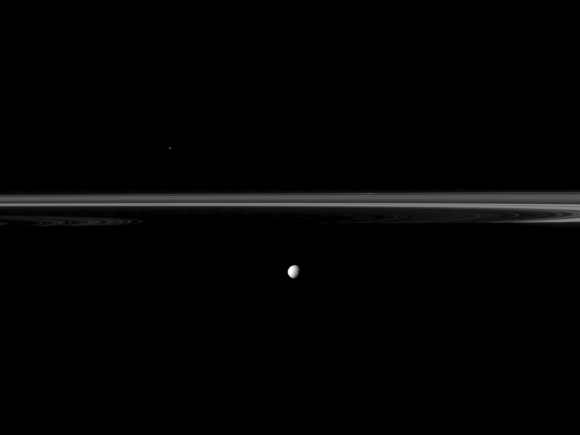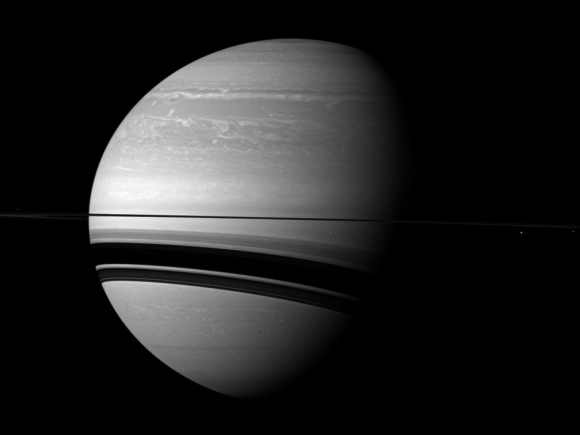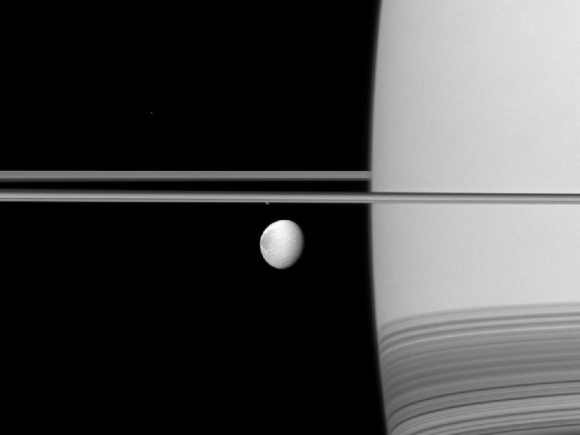 | « Back to article | Print this article |
UP CLOSE: Saturn's glorious rings and mysterious moons
Amazing new images captured by NASA's Cassini spacecraft currently orbiting the planet give a spectacular view of Saturn's rings and its moons.
The Cassini space probe, for the first time in two years, has been able to get a good view of the planet's famous rings owing to a recent change in the spacecraft's angle of orbit. It took seven years for Cassini to travel the two billion miles to Saturn. Here's a look at some stunning pictures of Saturn, like you have never seen before.
A quintet of Saturn's moons -- Janus, Pandora, Enceladus -- come together in the Cassini spacecraft's field of view for this portrait.
Saturn's second largest moon, Rhea is bisected by the right edge of the image. The smaller moon Mimas can be seen beyond Rhea also on the right side of the image.
Click NEXT for more PHOTOS...
UP CLOSE: Saturn's glorious rings and mysterious moons
Saturn's moon Mimas joins the planet's rings which appear truncated by the planet's shadow in this Cassini spacecraft image.
Saturn is off to the left, out of view here. The inner rings are just visible there. But the planet's shadow covers part of the rings across the middle of the image. Mimas is closer to Cassini than the rings are here.
The bright speck above the rings is a star.
UP CLOSE: Saturn's glorious rings and mysterious moons
Saturn's largest moon, Titan, looks small here, pictured to the right of the gas giant in this Cassini spacecraft view.
Titan is in the upper right. Saturn's rings appear across the top of the image, and they cast a series of shadows onto the planet across the middle of the image.
The moon Prometheus appears as a tiny white speck above the rings in the far upper right of the image.
UP CLOSE: Saturn's glorious rings and mysterious moons
A pair of Saturn's many moons joins the planet in this Cassini spacecraft scene.
Tethys appears as a small white dot above the rings on the far left of the image. Enceladus appears as a smaller bright speck beside the planet as seen from this vantage point. The rings cast wide shadows on the planet's southern latitudes.
UP CLOSE: Saturn's glorious rings and mysterious moons
NASA's Cassini spacecraft took this raw, unprocessed image of Saturn's moon Rhea on March 10, 2012. The camera was pointing toward Rhea at approximately 42,096 kilometers away.
UP CLOSE: Saturn's glorious rings and mysterious moons
The Cassini spacecraft examines Saturn and the planet's northern hemisphere, which was ravaged by a huge storm.
UP CLOSE: Saturn's glorious rings and mysterious moons
The Cassini spacecraft views Saturn with a selection of its moons in varying sizes.
Saturn's largest moon, Titan, is in the center of the image.
UP CLOSE: Saturn's glorious rings and mysterious moons
Even in a peaceful looking scene such as this one of Saturn and its moon Tethys, the Cassini spacecraft reveals clues about how Saturn is ever-changing. Saturn's northern hemisphere still shows the scars of the huge storm that raged through much of 2011.
UP CLOSE: Saturn's glorious rings and mysterious moons
Saturn's moon Tethys, with its stark white icy surface, peeps out from behind the larger, hazy, colorful Titan in this Cassini view of the two moons. Saturn's rings lie between the two.
UP CLOSE: Saturn's glorious rings and mysterious moons
Saturn's moon Dione coasts along in its orbit appearing in front of its parent planet in this Cassini spacecraft view.
TOP photo features of the week
Click on MORE to see another set of PHOTO features...










